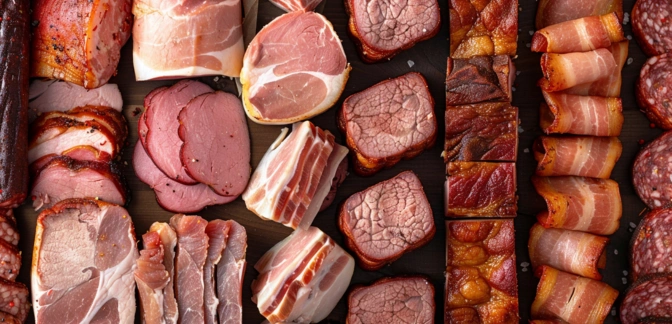Pork Loin — Nutrients, Health Benefits, And Shopping Tips

Written by Listonic Team
Last update on September 4, 2024
Pork loin nutrients
Nutrition facts
Amount per 100 g
Calories
🔥 143 kcal
| Nutrition per: 100 g | Value | % Daily Value* |
|---|---|---|
| Carbs | 0 g | - |
| Fiber | 0 g | - |
| Sugars | 0 g | - |
| Glycemic Index | 0 | - |
| Protein | 27 g | 54% |
| Sodium | 62 mg | 2.7% |
| Total Fat | 4 g | 5.13% |
*The % of Daily Value (DV) tells you how much a nutrient in a serving of food contributes to a daily diet. 2,000 calories a day is used for general nutrition advice.
27 g
💪 High Protein Content
Pork loin facts & tips
Health benefits
- High in protein, essential for muscle growth, repair, and overall body function.
- Low in fat, making it a heart-healthy option compared to fattier cuts of pork.
- Rich in B vitamins such as B6 and B12, supporting energy metabolism and brain health.
- Contains essential minerals such as iron and zinc, which support immune function and overall health.
Health risks
- Potential for high sodium content in processed or seasoned pork loin, which can contribute to hypertension and increased cardiovascular risks.
- High fat content though pork loin is generally leaner than other cuts, excessive consumption can still contribute to increased cholesterol levels.
- Risk of contamination with harmful bacteria such as Salmonella or Trichinella, particularly if the pork is not properly cooked to a safe internal temperature.
- Potential for overconsumption due to its tender nature, leading to excessive calorie intake if not mindful of portion sizes.
How to choose pork loin
Pork loin should have a consistent pink color and a layer of fat along the edge to enhance flavor when cooked. The texture should be smooth and the meat should feel firm to the touch.
Do not choose pork loin with a grayish hue or that is sticky, which can indicate that the meat is past its prime. Pieces that have an off odor or are excessively fatty should also be avoided, as they can affect the cooking outcome.

How to store pork loin
Fresh pork loin should be kept in the refrigerator, tightly wrapped in plastic wrap or butcher paper. Keep it in the coldest part of the fridge to maintain freshness for up to five days. Freezing is ideal for longer storage.
Leaving pork loin exposed to air can cause it to spoil quickly. Avoid storing it near ready-to-eat foods to prevent cross-contamination. Always use a clean cutting board and utensils to handle pork loin to maintain its quality and safety.
✅ Extra Tip
How long does it last?
Pork loin can last for 1-2 days in the refrigerator. For longer storage, pork loin can be frozen for up to 6-8 months. Proper packaging, such as vacuum-sealing, helps maintain its quality over longer storage periods.
What to do with leftovers?
Leftover pork loin can be used in a variety of savory dishes. Slice it thinly and add to sandwiches, wraps, or salads for a flavorful protein source, or chop it up and mix into a stir-fry with vegetables and rice. Pork loin is also great when added to pasta dishes with a tomato or cream sauce, or used as a filling for tacos, burritos, or quesadillas.
Use pork loin in a casserole with potatoes, vegetables, and cheese, or mix it into a soup or stew for added richness and flavor. If you have a lot of pork loin, consider making a batch of pulled pork sandwiches with barbecue sauce and coleslaw, or using it as a topping for pizzas or flatbreads. Pork loin can also be added to salads with greens, nuts, and a tangy vinaigrette, or served over a bed of quinoa or rice. For a quick snack, reheat pork loin slices and serve with a dipping sauce or on a bed of greens.
👨⚕️️ Medical disclaimer
Discover products from other categories
Listonic Team
Fact-checked
Our editorial team checked this article to make sure it was accurate at the time of publishing it.
Get the top-rated shopping list app

pork loin
1 piece
Outline







